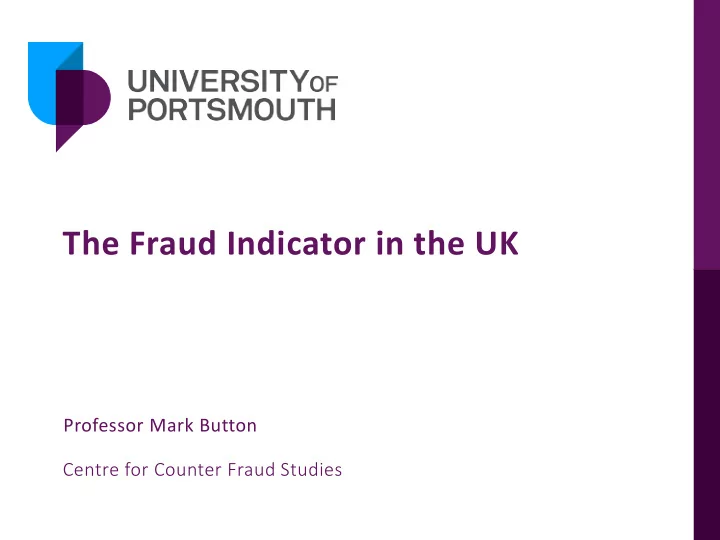

The Fraud Indicator in the UK Professor Mark Button Centre for Counter Fraud Studies
Outline of Presentation • General measures of fraud • Past measurement of fraud • The annual fraud indicator and fraud
There’s no fraud here, I’ve got the statistics to prove it!
Measures of fraud • Crime statistics • England and Wales crime survey • Detected statistics • Barometers • Survey guestimates • Public expenditure tracking surveys (PETS) • Random sampling • Fraud loss measurement • Baskets of estimates
Random sampling
What is fraud loss measurement? • FLM focuses on a particular type of expenditure or activity (payroll, procurement, social security payment, insurance claim etc) • Select a statistically valid sample (usually 1700+) • Assess each case for existence of fraud, using the civil test and making higher checks than the normal audit • Identify each case as Fraud, Error or OK • Extrapolate to an overall level of fraud giving the statistical confidence level of the estimate • Varies usually between 90% or 95% confidence levels at range of 1% to 2.5%
Examples of fraud loss measurement?
Evaluating FLM • Challenges • Benefits • Can only be used on • Accurate measurement comparable • Enables clear ROI to be transactions: demonstrated procurement, insurance • Uncovers where claims, payroll etc problems are, which can • Costly and timely then be dealt with • Will end result be politcaly palatable
Average cost of fraud reports
Annual fraud indicator
Old AFI total costs National Fraud Indicator £B 80 70 60 50 40 National Fraud Indicator £B 30 20 10 0 2010 2011 2012 2013
Abolition of National Fraud Authority and AFI
The new fraud indicator • Establishment of a UK Fraud Costs Measurement Committee • Agreed methodology in partnership with UoP, Experian and PKF/Crowe Clark Whitehill
Ctd • Focus upon expenditure NOT GDP • GDP is “..the monetary value of all the finished goods and services produced within a country's borders in a specific time period.” • Focus instead upon public expenditure and private sector expenditure • Total turnover for UK private sector excluding financial and insurance activities is £3,739,171 million (i.e. £3.7 trillion). Total turnover for non-profit sector is £93,824 million (i.e. £94 billion). • Adding these three figures gives us £4.6 trillion • 1% fraud rate on this would be £46 billion • 5% fraud rate would be £230 billion • Committee uses a variety of fraud rate estimates ranging from the financial cost of fraud discounted rate, application fraud rate, specific exercises on procurement/payroll etc • Also uses past specific data uprated for inflation
Healthcare costs 2016-2017
Any questions?
Recommend
More recommend